
Edward Darley Boit
For this blog I am reverting to my early modus operandi when I concentrated the blog on one painting, rather than, as I do nowadays, focus on the artist(s). Having said that, the blog revolves around two American artists, one who is rightly categorised as one of the great nineteenth century painters and the other, who is less well-known, is now almost forgotten. One is the artist who painted the work and the other is the father of the four girls who are depicted in the painting. The artist was John Singer Sargent, the American expatriate painter, considered the leading portraitist of his generation and the father of the girls depicted in the work is Edward Darley Boit, a watercolour painter from Boston. The work of art I am featuring is entitled The Daughters of Edward Darley Boit, which was originally titled Portraits d’enfants.
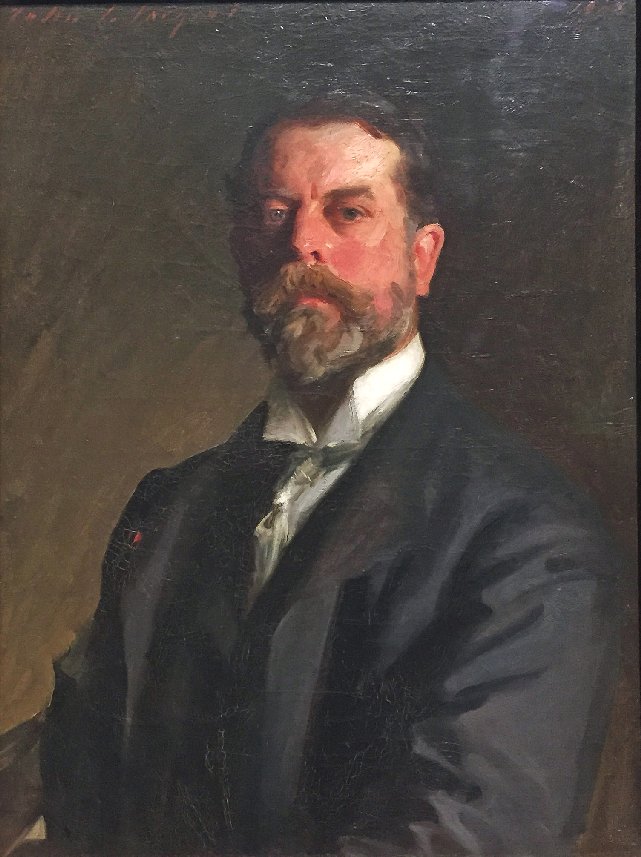
John Singer Sargent – Self-Portrait (1906)
Edward Darley Boit Jnr., known as Ned, was born in 1840. His father, also Edward Darley Boit, was a Harvard-educated lawyer and his wife was Jane Parkinson Hubbard whom he married in 1839. Jane’s family, the Hubbards, were an old New England family who owned sugar plantations in British Guyana. The couple had three sons, Edward (Ned), Robert (Bob) and John and two daughters, Jane and Elizabeth. His son, Edwards Darley Boit Jnr. studied at the Boston Latin school and then Harvard where he graduated in 1863. From there he went on to study at Harvard Law School.
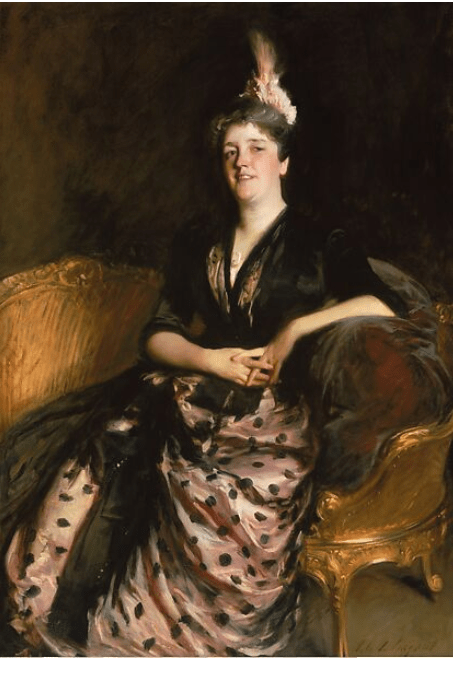
Mrs Edward Darley Boit(Mary Louisa Cushing) by John Singer Sargent (1887)
Edward’s love of legal matters soon waned despite his aptitude in his legal studies. However it was his love of art which came to the fore in his life but it was not just art that was to enter his life. There was a woman who would take a leading role in the life of Edward (Ned) Darley Boit junior. She was Mary Louisa Cushing, known simply as Isa, who was part of the upper-class Bostonian Society. Her great uncle was Thomas Handasyd Perkins hailed from a wealthy Boston Brahmin family and was an American merchant, slave trader, smuggler, philanthropist and early patron of the Arts. Isa’s father, John Hubbard, worked for his uncle’s merchant’s businesses in China. He returned to America in 1831, a very wealthy man and a very eligible bachelor. Isa’s father met and fell in love with her mother, Jane Parkinson, and the couple married in 1839. In 1840, they moved to their Bellmont estate in Watertown, Massachusetts. They had five children, four sons and one daughter, Mary Louisa (Isa). Isa was brought up in a wealthy household and wanted for nothing.
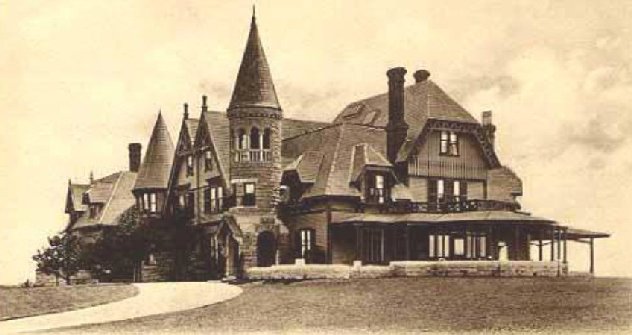
Edward and Isa’s summer home, The Rocks
Despite her wealthy upbringing, tragedy was to strike Isa in 1862 when she was still only sixteen years old. In April of that year her father died, aged 75 and less than two months later, in early July her mother Mary Louisa Cushing died. She was 63. Isa went live with her elder brother Ned who acted as her legal guardian. On June 16th 1864, with the American Civil War still raging, twenty-four-year-old Edward Darley Boit, who was still studying law and was exempt military service, and seventeen-year-old Isabel Louisa Cushing married in an Episcopal ceremony at Christ Church in Harvard Square, Boston. It was a sumptuous, no-expense spared affair. The young couple split their time between Boston and Newport, Rhode Island where they had their summer house built. It was known as The Rocks, and was situated above Bailey Beach and just along from Isa’s brother, Robert’s home.
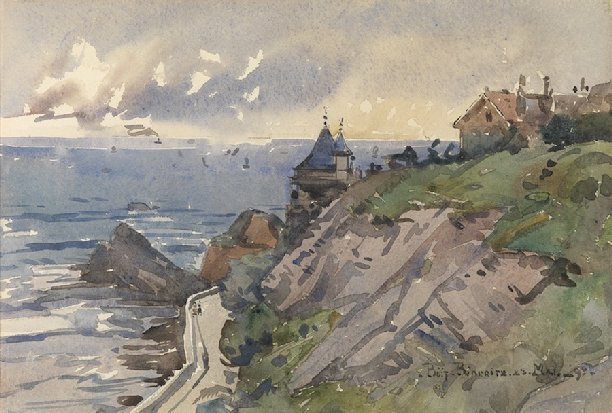
Biarritz by Edward Darley Boit
In April 1865 Isa Boit gave birth to their first child, named Edward after his father but was known as Neddie. The following year Edward Darley Boit was admitted to the Massachusetts Bar and once again Isa was pregnant. That summer Edward Boit, his pregnant wife and their son travelled to Europe visiting Dublin, Paris, Rome before returning to the French capital. Throughout the European journeys Edward was continually visiting the major city art galleries and absorbing as much as the European art as he could. In the Autumn of 1886 they returned to London where Isa gave birth to their second child, a son called John. Neither Isa nor John were well following a problematic birth but their travels continued and they returned to Paris, their favourite city, in mid-December 1866. However Edward wanted to once again visit Italy to study the works of the Italian Renaissance Masters and so Edward, Isa, Neddie and baby John went to Rome visiting Genoa and Florence en-route. Five month old baby John was became very ill and never recovered his health. He died in March 1867 and was buried in the Protestant Cemetery in Rome. Edward, Isa and Neddie returned to Boston where Edward resumed his legal career.

Italian Landscape by Edward Darley Boit
Edward Boit visited an art exhibition at Boston’s Soule and Ward gallery and for him it was a magical visit and he was overwhelmed by the landscape work of Jean-Baptiste-Camille Corot and how the French painter had managed to capture the light, air and atmosphere in his works. It was an epiphany for Boit who there and then decided that he would give up law and become a painter and furthermore he and the family would leave America and live in Paris. Edward’s wife Isa supported him both passionately and financially having received a sizeable inheritance from her late parents. Isa preferred life in Paris to that of life in Boston.
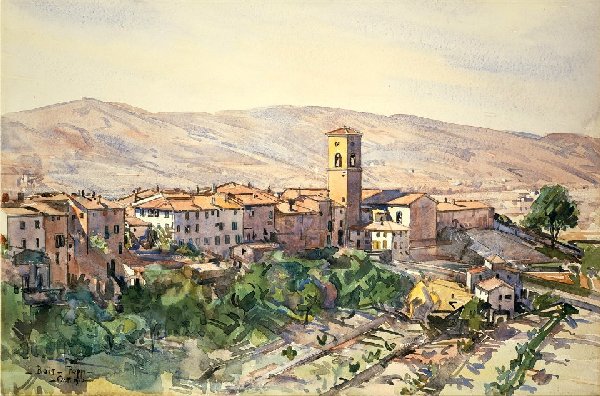
Poppi in the Casentino, Tuscany by Edward Darley Boit
Whilst in Newport Rhode Island, the size of the Boit family had increased. A daughter, Florence, was born on May 6th 1868 and a second daughter, Jane, was born on January 17th 1870. There was one major problem to the Paris relocation plans. Their eldest son, now five-years-old, suffered from severe mental retardation and was now living in a “home”. Edward and Isa had a heartbreaking decision to make as to whether to stay in Boston to be near him, albeit he didnt recognise them and could not communicate or leave their son behind when they emigrated to Paris. After a lot of soul searching they decided to relocate the family and leave Neddie behind in the specialist home. In the Autumn of 1871, Boit gave up his conventional legal life, and the couple sold their Newport home and moved to Europe with the family, visiting Italy first then travelling around the French countryside before arriving at their ultimate destination, Paris. One of the first things Boit picked up about French art was the way they cared less for detail and concentrated on overall effect liberation. Edward Boit and his family split their time between Paris and Rome and enjoyed all that French and Italian society had to offer. Among the close friends they met were the author, Henry James and the young artist Frederic Crowninshield both of whom had connections with Boston. In 1876 Boit decided to make Paris his base and had rented a studio at 139 boulevard Montparnasse in the city’s Left Bank artist quarters. At the start of his Parisian residency he began to be tutored by the French landscape artist François-Louis Français, who himself had been a pupil of Corot, one of Boit’s favourite painters.

Avenue de Friedland, Paris.
In 1874 the Boit family increased with the birth of a third daughter, Mary Louisa on June 5th in Paris and eighteen months later on November 15th 1878 a fourth daughter, Julia, was born in the northern Paris suburb of Soissy. Edward and Isa decided that it was now time to return to America for a long stay so as to introduce their daughters to their uncles and grandparents and in mid-June 1879 they, along with European governesses and nurses, boarded SS Bothnia for the Atlantic sea passage. Great celebrations followed their arrival and Edward’s parents looked forward to Edward and his family remaining over the winter months in Boston, but their hopes were dashed when Edward outlined his plans to return to Paris. The voyage back to France took place in early October 1879. On arriving back in Paris they took a large apartment on the avenue de Friedland, a large boulevard that radiated out from the Place d’Etoile,

Portrait of Robert de Cévrieux with his Pet Dog by John Singer Sargent
There is some doubt as to when Edward and Isa Boit met the artist, John Singer Sargent but it is thought most likely it was in Paris in the late 1870s during one of the many artistic soirees that the Boits and Sargent frequented. Another possible reason was the meeting came about through the auspices of Edward Boit’s teacher, François-Louis Français, whose close friend was Carolas-Duran, one of Singer Sargent’s tutor. Sargent was an expert portraitist and a third of them were commissions to paint children. An example of one such painting is Sargent’s 1879 Portrait of Robert de Cévrieux with his Pet Dog. We see him standing on an oriental rug in front of a curtained backdrop.
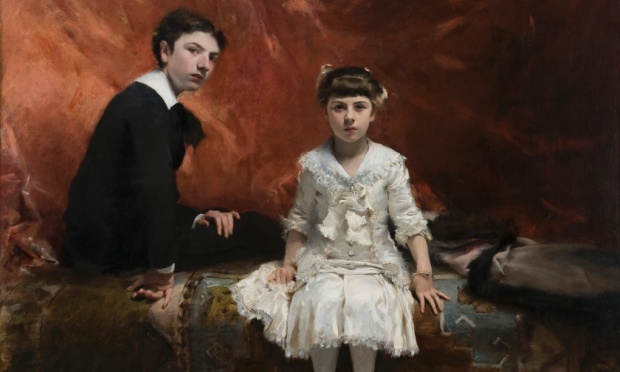
Portrait of Edouard and Marie-Loise Pailleron by John Singer Sargent (1881)
Another child portrait by Sargent was a commission from one of Sargent’s earliest patrons, Edouard Pailleron, the French poet and dramatist. Sargent had completed a portrait of Edouard and his wife in 1879 and two years later, a portrait of Edouard’s two children, sixteen-years-old Edouard and his younger sister, Marie-Louise, which was exhibited at the 1881 Salon. The children’s portrait was time consuming and Marie-Louise, later recorded that there were eighty-three sitting for this painting which might explain why the subjects seem strangely remote from the artist.
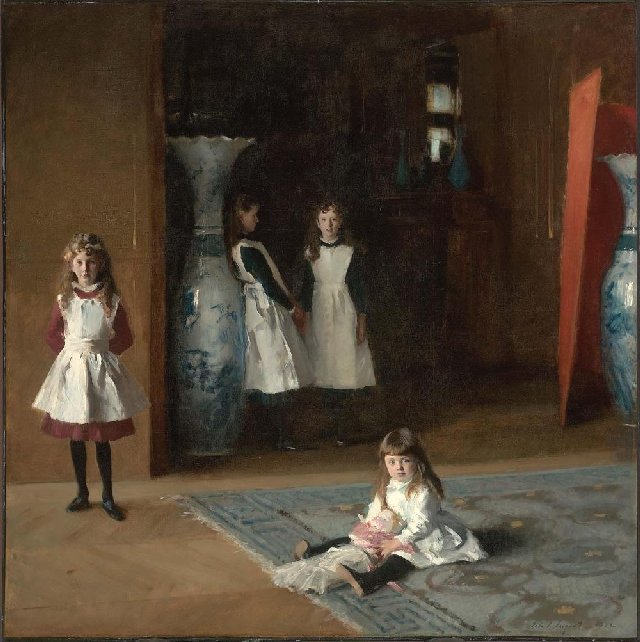
The Daughters of Edward Darley Boit by John Singer Sargent (1882)
The painting I am concentrating on in this blog, The Daughters of Edward Darley Boit, is one that Sargent started on in October 1882 after he returned to Paris from Italy. He completed the work in December, a mere two months later. This was a great achievement as the painting was so large (225 x 255 cms) 87.6 inches square. Sargent titled the painting Portraits of Children and it was then shown at Georges Petit’s Exposition de la Société Internationale and the following year at the Salon. It is an unusual depiction in as far as, that besides the four girls and two large vases, the location seems empty, even stark. This would be completely different to the real Boit household which was known to be full of furnishings which they had collected on their travels over the years. The stylistic interior tastes of the Boits is not reflected in this portrait with the exception of the vases. Maybe Edward and Isa first approached Sargent tasking him to paint a traditional portrait of their four daughters but subsequently they may have acceded to Sargent’s decision to make the depiction part portraiture and part an interior genre painting.

Mary Louisa (Isa) Boit
The setting for this portrait is one of the rooms in the family’s spacious apartment, possibly the foyer. Edward and Isa had moved into the apartment on the avenue de Friedland, a large boulevard that radiated out from the Place d’Etoile, Their elegant residence was situated in the eighth arrondissement, a luxurious neighbourhood much preferred by wealthy Americans. They had lived there since 1879 when they had arrived back from a summer in Newport, Rhode Island. It was to be home to the Boits until 1886.
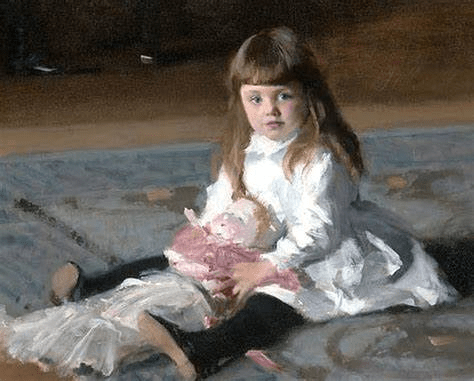
Julia Overing Boit
In the painting, the light comes from the left. The two older daughters are shielded from it by the recessed enclave they stand in, a position which they have found for their uneasy refuge. All the girls wear white pinafores, which gives Sargent the opportunity to show off his absolute mastery of a full range of tones created by the folds and creases in the pinafores. It was a dark shadowy space in which Sargent then positioned the Boits’ four daughters. The youngest daughter, four-year-old Julia sits on the floor, eight-year-old Mary Louisa stands at the left midground of the painting whilst the two older daughters, Jane, aged twelve, and Florence, fourteen, stand in the background, partially obscured by shadow.

Painting with the vases at the Museum of Fine Arts, Boston.
Besides the four girls the other striking feature of the painting is the inclusion of the two tall vases. These were not Sargent’s props but two Japanese vases owned by the Boits, which Sargent faithfully depicted, although he subdued the colour allowing the girls to be the more important. The vases, like their owners, criss-crossed the Atlantic more than a dozen times and only suffered minor damage to their rims. They were six feet tall giants, the tops of which flared into scalloped ripples of porcelain. The size of them dwarfed the girls. They were made in Arita, Japan an area famous for its porcelain, which in the late nineteenth century was specifically made for export to the West. The two oversize Japanese porcelain vases depicted in the work were, along with the painting, also donated by the Boit family to the Boston Museum of Fine Arts and are exhibited beside Sargent’s painting.

Florence Dumaresq and Jane Hubbard Boit
The painting by Sargent is not a conventional group portrait as Sargent has positioned the four girls individually. There is no connection between the siblings. The two older sisters are placed in the semi-shade in the background while the youngest is centre stage in the foreground holding her doll and the other girl is standing alone off to the left. Each of the girls is presented individually, but the features of the two older girls are obscured, by the darkness of the background. The presence of empty space, and the isolation of the figures all add to the sense of quiet anxiousness. Florence with her back to the vase comes over as being independent and refuses to participate at all and Jane, facing us, is left unsure whether to side with her big sister or to emerge from the shadows and face the artist.
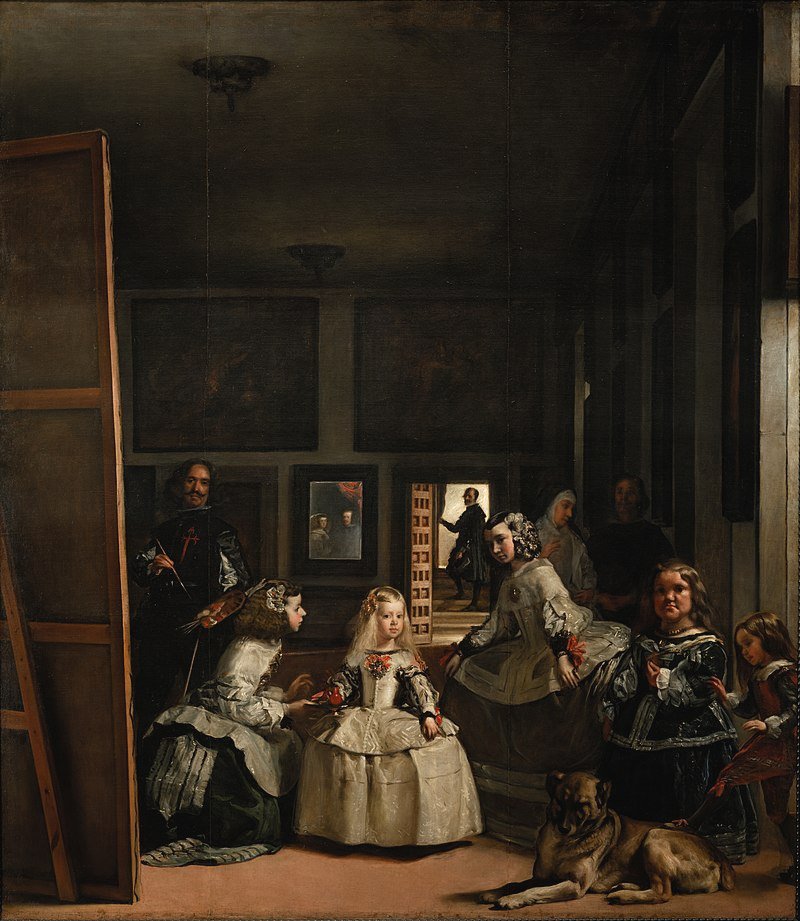
Las Meninas by Velazquez (1656)
Many art historians have likened the position of the girls with way Velazquez set up the figures in his painting, Las Meninas, the famous portrait of the young Spanish infanta with her maids in a great shadowed room. Sargent had studied and copied this work during his 1879 visit to the Prado in Madrid.

A composite image of Las Meninas by Diego Rodriguez de Silva y Velazquez and The Daughters of Edward Darley Boit by John Singer Sargent.
The relationship between these two works was considered so noteworthy that the Museum of Fine Arts in Boston who owned the Boit family portrait loaned it to the Museo del Prado in 2010, so that the paintings could be exhibited together for the first time.
Malcolm Rogers, the director of Boston’s Museum of Fine Arts at the time of the loan, when asked about the similarity of the two works of art stated;
“…These two great paintings have never been together in one room before……It is Sargent’s greatest painting, one of the great paintings of childhood and for it to hang side by side with arguably the world’s greatest portrait of childhood has to be a historic and iconic moment. I think people will be very moved…”
When the Daughters of Edward Darley Boit was first exhibited in 1883, the depiction of the children was the subject of much discussion. Many art critics were confounded as to why the children were so isolated from each other and also why is one in profile and almost indistinct? Again Malcolm Rogers postulated:
“…The Boit daughters is just one of those paintings that moves people because of its beauty, but also its mystery. You don’t quite know what these four girls are thinking; it opens up your own imagination. It’s got a little bit of sadness, a little bit of happiness, a little bit of childishness, great beauty. It is a very intriguing work…”
I will end this blog with a brief summary of what happened to the family. Isa, Edwards wife, was taken ill in the summer of 1894 and by the Autumn she had suffered from increasing paralysis of her limbs and both her heart and lungs began to fail. She died in Dinard, France on September 29th 1894 aged forty-eight and was buried in Paris, the city she loved so much. Edward refused to return to Boston in deference to Isa who had hated living in the American city.
In Biarritz, in the summer of 1895, Edward became re-aquainted with a young girl, Florence McCarty Little, who he had first met in Boston and was a firend of his twenty-one year-old daughter Isa. To everybody’s shock and his daughters’ horror Edward and Florence became very close and and they announced their impending marriage. Florence was thirty-six years younger than Edward.
Edward Darley Boit and F lorence set June 1896 for the marriage ceremony but it was postponed until October. His four daughters were sent back to Boston to stay with their aunt, Jane Boit Hunnewell in Wellesley. Edward’s brother Bob tried to dissuade his brother from marrying such a young girl saying that he was acting like a selfish, infatuated, silly school-boy and that he was appalled by his brother’s “abandonment” of his children. His daughters’ cousin Mary Boit returned to Paris with the four girls in October and wrote about the atmosphere at her cousins’ home:
“…I think he seems quite pre-occupied and now we are over hereUncle Ned says he is going to marry Florence Little next month. Well it is a very strange thing and I am more sorry for the girls than anything. poor dears, it seems so queer to look at Uncle Ned then think he is in love with somebody my age…”

Edward Darley with his sons, Julian and Edward.
The marriage finally took place in Biarritz on January 5th 1897 and on June 21st 1900 Florence gave birth to their first child, a son, Julian. Two years later, on April 12th 1902 she gave birth to their second son, Edward. Sadly, two weeks after the birth of Edward, Florence contracted a fever and died on April 24th, aged 25. Edward Darley Boit died of arteriosclerosis in Rome on April 21st 1915, three weeks before his 75th birthday.
None of the four daughters, depicted in the painting, married. The eldest, Florence Dumaresq died in 1919, aged 51. The second born daughter, Jane Hubbard Boit had suffered a nervous breakdown and never completely recovered. Her father was concerned that she would end up in a mental asylum like his first-born, Neddie. She improved and in fact, went to live on her own in a Paris apartment. She died in New York State in November 1955, aged 85. Mary Louisa Boit, the girl who stood alone on the left of Sargent’s painting, and who was looked upon as the prettiest of the four girls, died in New York in June 1945, aged 71.

Woman in Blue, Apartment in Paris by Julia Overing Boit (1921)
The youngest aughter, Julia Overing Boit, became a talented watercolour painter and often her letters contained small watercolour sketches. Her work was exhibited in many exhibitions and in March 1929 at the Copley Gallery in Boston, sixty-six of her watercolours were exhibited. She died in February 1969, aged 91.
Most of the information for this blog came from an excellent book which I bought from Amazon. It is entitled Sargent’s Daughters, The biography of a portrait, by Erica E Hirshler. If you would like a greater in-depth read about the Boit family and the painting, this is a must-have book.

Enjoyed learning more about this famous painting. Lots of info. Good list.
Thanks for this intriguing analysis and background of the painting. I am so happy to have read it! Hope to see the original soon and in new light!!